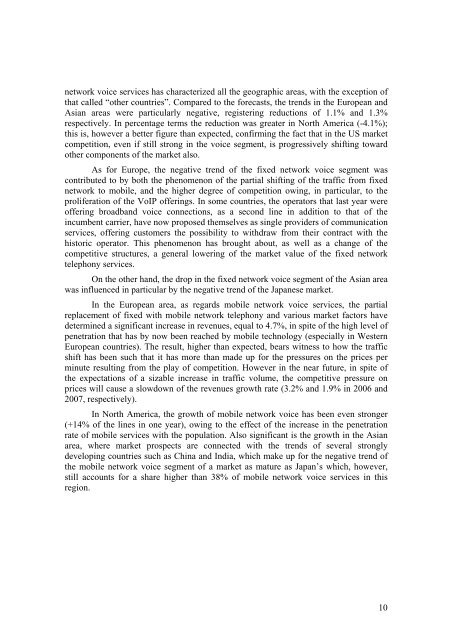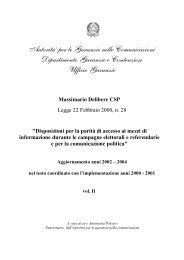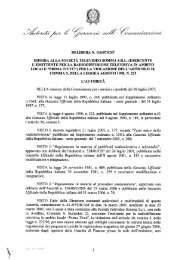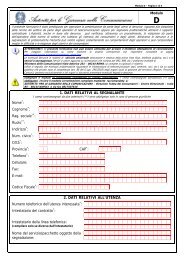Communications Regulatory Authority
Communications Regulatory Authority
Communications Regulatory Authority
Create successful ePaper yourself
Turn your PDF publications into a flip-book with our unique Google optimized e-Paper software.
network voice services has characterized all the geographic areas, with the exception of<br />
that called “other countries”. Compared to the forecasts, the trends in the European and<br />
Asian areas were particularly negative, registering reductions of 1.1% and 1.3%<br />
respectively. In percentage terms the reduction was greater in North America (-4.1%);<br />
this is, however a better figure than expected, confirming the fact that in the US market<br />
competition, even if still strong in the voice segment, is progressively shifting toward<br />
other components of the market also.<br />
As for Europe, the negative trend of the fixed network voice segment was<br />
contributed to by both the phenomenon of the partial shifting of the traffic from fixed<br />
network to mobile, and the higher degree of competition owing, in particular, to the<br />
proliferation of the VoIP offerings. In some countries, the operators that last year were<br />
offering broadband voice connections, as a second line in addition to that of the<br />
incumbent carrier, have now proposed themselves as single providers of communication<br />
services, offering customers the possibility to withdraw from their contract with the<br />
historic operator. This phenomenon has brought about, as well as a change of the<br />
competitive structures, a general lowering of the market value of the fixed network<br />
telephony services.<br />
On the other hand, the drop in the fixed network voice segment of the Asian area<br />
was influenced in particular by the negative trend of the Japanese market.<br />
In the European area, as regards mobile network voice services, the partial<br />
replacement of fixed with mobile network telephony and various market factors have<br />
determined a significant increase in revenues, equal to 4.7%, in spite of the high level of<br />
penetration that has by now been reached by mobile technology (especially in Western<br />
European countries). The result, higher than expected, bears witness to how the traffic<br />
shift has been such that it has more than made up for the pressures on the prices per<br />
minute resulting from the play of competition. However in the near future, in spite of<br />
the expectations of a sizable increase in traffic volume, the competitive pressure on<br />
prices will cause a slowdown of the revenues growth rate (3.2% and 1.9% in 2006 and<br />
2007, respectively).<br />
In North America, the growth of mobile network voice has been even stronger<br />
(+14% of the lines in one year), owing to the effect of the increase in the penetration<br />
rate of mobile services with the population. Also significant is the growth in the Asian<br />
area, where market prospects are connected with the trends of several strongly<br />
developing countries such as China and India, which make up for the negative trend of<br />
the mobile network voice segment of a market as mature as Japan’s which, however,<br />
still accounts for a share higher than 38% of mobile network voice services in this<br />
region.<br />
10















